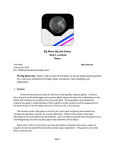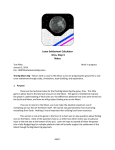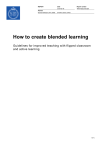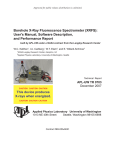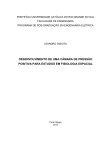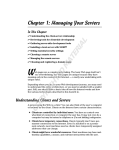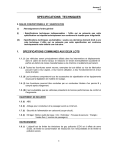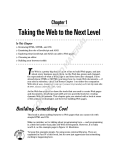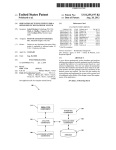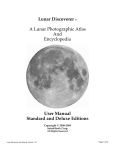Download BMD Lite Games, Step 2 Habitat Notes
Transcript
Lunar Settlement Calculator Habitat, Step 2 Notes Beta Version Tom Riley December 31, 2013 File: BMDHabitatNotesmmddyy.docx The Big Moon Dig – Return with us now to the Moon as we are preparing the ground for a real lunar settlement through study, simulations, team building, and exploration. 1. Purpose This specialty calculator is intended to help people understand what it would take to build a settlement on the Moon and to understand the Big Moon Dig (BMD) approach. It lets the user calculate several critical parameters for a buried, inflated lunar habitat. We trust that these calculations will help them better understand what we are trying to do and why. This version is only a lite game in the form of a short quiz on figuring out answers to key concepts of a lunar habitat design which are calculated in the background. Later we hope to expand these lite games into a fully fledged App that will actually support the settlement of the Moon. Above all, to return to the Moon we must get millions of people to buy into a vision of progress for all humankind that includes manned space exploration. This game is one small step in that process. BMD 1 2. The Big Moon Dig Way The Big Moon Dig is a specific approach to problem of humanity returning to the Moon and building settlements there: We start with the idea that the human population of the Earth will build to a peak of about 10 billion around 2050 and then move on to a sustainable Earth. This process will be difficult, dangerous, and historic. But it will also be exciting, even exhilarating. Through out this difficult time, humanity will need visions of positive futures and great tasks to keep our efforts positive and productive. Space exploration is certainly one of those great tasks. We ask the question: On a world of 10 billion people what is your greatest resource? We answer: 10 billion people! We also note that if we try to tackle the problems of the 12st century using only the tools of the 20th century we will surely fail. Our approach then is to use tools of the 21st century, like the Internet and social media, to take on one great problem, furthering the human exploration of space. One of our tools is a complete reorganization of how space exploration is done called a Massive Online Vetted Exploration (MOVE). In the 19th century, a few dozen people participated in grand polar expeditions and a few hundred thousand followed the much delay accounts in the newspapers. In the 21st century millions of people will participate in grand explorations over the Internet and billions will follow them near instantaneously through social media. Our short stories and these lite games are early steps in the MOVE expeditions. If all that is just a little heavy for you, then let’s just go back to the Moon for the fun of it! 3. General Game Notes We are not trying to make this game hard; getting back to the Moon has proved hard enough. You may correct your entries on each question as often as you like by simply making changes and pressing the [Submit] button again. Your score for each question is shown with each submission. There is a maximum of 10 points per questions but you are penalized for wrong answers. A hit for doing better is given after each submission. BMD 2 The name requested is just for reference only and can be an internet nickname or character name if you prefer. It helps if you keep the same name on all our lite games so that you can be entered you correctly on our BMD Leader Board. Most of the entry boxes for technical information in this calculator will provide a list of example entries if you left click on the center of the box. You can enter a number instead of making a selection, but what you type must end with the same units that are shown in the examples, (for example: 101.2 kPa). A few entry boxes require a number only. On these, the units are given right after the box (for example: [______] meters) so the entry is a number only. If your entry cannot be converted to a number, the calculator takes a guess and labels the result: "-- Guess, entry not a number". This is usually caused by the units not being exactly right. All inputs will be entered with the click of the adjacent [Submit] box. All inputs are then repeated to the screen so that you can verify what was actually entered. Wrong entries can simply be replaced and resubmitted. When you get all your answers to the best of your present ability, you will be invited to archive the result. This simply means your result will be automatically e-mailed to The Big Moon Dig when you click the [Submit] button. There it will be added to the archive file and this will make you eligible to be on our BMD Leader Board. 4. Getting Help The notes below cover most of the quiz material. You can find additional helpful resources on the Big Moon Dig Site: • • • • • • The Big Moon Dig home The Big Moon Dig games BMD Lite Game on Lunar Locations An Excel spreadsheet with all the calculations and source data: o In .pdf o in .xlsx Graphics of settlements and equipment Stories based on the Big Moon Dig effort Please contact us with our feedback form if you have any questions. 5. Naming Conventions BMD 3 By international treaty, the primary system of measurement on the Moon is the System International (SI), the metric system. All calculations will be done in SI first. The now obsolete English system value is sometimes provided in parentheses. For historic reasons, and again by international agreement, human habitations off Earth are always referred to as “settlement” and never “colony”. One only has to think back to the American Revolution to appreciate the terrible baggage the word "colony" carries. Few mountain tops on the Moon have formal names. The peaks are commonly given the name of the nearest named crater. When the word "Moon" is capitalized, it refers specifically to Earth's moon as a proper noun; when it is used in lower case, it can mean any moon. The Moon's other formal name, Luna, is almost never used. This is a bit sad as the name beautifully refers to a young goddess who is the huntress of the night. The Sun's formal name is even more neglected, Saul. 6. Details on Radiation Protection Problem “Houston, we have a problem” BMD 4 Since I wrote the first short stories that became the “Hard Squared Science Fiction” series, new science has rendered their lunar settlement design dangerously obsolete. A complete redesign of their technical aspects and a rewrite of the stories and games are now mandatory. Also with the new century has come new design processes that must be used as well. The recent space missions Lunar Reconnaissance Orbiter (LRO) and Curiosity carried instruments specifically designed to measure the danger of space radiation to human beings. Their results are now in and not what we wanted to hear at all. The radiation danger for humans in space is much worse than we foresaw, in fact, it is about twice as bad. There are two separate radiation dangers for a manned space mission, Coronal Mass Ejections (CME) or solar storms, and Galactic Cosmic Rays (GCR). Our old lunar settlement design considered CME’s to be the worst problem and was designed to deal with them, but this turned out to be wrong, dead wrong. The real problem is GCR. Galactic cosmic rays are not as concentrated as a CME at its peak, but they are very penetrating. They are present 24/7/365 and they will go through a space suit, they will go through a spacecraft skin, and they will go through a meter of lunar regolith. To make matters worse, insufficient radiation shielding will work against you. A thin shield only increases deadly secondary radiation. CME's are still a problem as we can expect zero to five solar radiations storms a year each lasting up to 72 hours at any location on the Moon. Earth's magnetic field diverts this radiation toward the poles where it creates the Northern Lights. The Moon however has no magnetic field to help provide protection. CME radiation is very intense but will not penetrate, one meter of lunar regolith will stop it. The shield thickness made necessary by GCR is more than adequate for CME's even without magnetic protection, but all surface operations will have to be stopped for each storm and all people brought inside. Fortunately it is easy to detect an oncoming CME and sound the alarm. It is clear that we now have to completely redesign all future manned space missions to deal with the higher radiation dangers. Every spaceship and every space settlement you have ever seen depicted, especially in movies, is simply a death trap. We need new ideas and we need your help. 7. Questions and Calculations The following questions are asked and the answers developed with this calculator: 1. How much lunar regolith is needed to equal the mass of the air above your head? The BMD approach assumes that if we can provide our lunar inhabitants with the same amount of protective mass over their heads that they evolved with on Earth, then this will provide adequate protection from radiation, micrometeorites, and heat extremes. We must BMD 5 use lunar resources to provide this mass so our choice is a thick layer of the dust, sand, and broken rock, called regolith, which covers the Moon's surface. The first input for this question is a location on Earth with its air pressure in kPa (kilo Pascals). The standard is sea level. Several input suggestions are given for high altitude cities on Earth with populations greater than 1 million for comparison. For this calculation, we start by taking the density of water in g/cm3 and convert it to kg/m3. This is straightforward: the definition of gram is a cubic centimeter of water and grams are a unit of mass, not weight. The number is then divided that by the gravitational constant of Earth (little g) to obtain the mass in kg/m2 of air on each meter of Earth’s surface. The number is then divided by the density of water with the answer in to meters. If you were to make a barometer with water as the working fluid, this is how tall your barometer would have to be. The calculator next requests the density of the lunar regolith from the second input box. The most commonly used value is the average density of all the core samples taken by Apollo to the Moon. This entry starts as text but is then converted to a floating point number in g/cm3 and again converted to kg/m3. This calculation is very similar to the one proceeding it, but we are now under the Moon’s gravity. The second answer is thus is the thickness of regolith in meters that will provide the same amount of radiation shielding mass provided by the mass of air above the location you chose on Earth. The answer for sea level is about six meters, while the answer for high altitude cities is around five meters. This is the source of the "5 Meter Rule" we are using in all the BMD games and stories for the minimum thickness of shielding that will be acceptable. Note that this is a BMD 6 minimum, not an average. Lunar Settlement Gym 2. Will your chosen habitat air pressure support the roof? This next section is basically a safety check. Let's see if the air pressure you choose for your buried habitats will support the weight of the shield over the roof. The calculation is basically the same as that in the previous question; again, we must use the Moon's little g. The answer makes sense. Any reasonable choice for habitat air pressure will support an acceptable roof shield with plenty of margin for safety. As mass of the air on Earth is equivalent to more than the mass of five meters of lunar regolith, one would expect that this air pressure on the Moon would support six times as much mass simply from the ratio of their little g's. BMD 7 Deflated Habitat inside Rocket Fairing 3. What mass of nitrogen do you need to ship from Earth for every 100 m3 of living space? This questions asks for the diameter of your habitat in meters. It assumes that the habitat can be approximated as an inflated tube with circular cross-section. This tube might either stand vertically or lay horizontally in a big trench. The size you can use in your design is largely limited by the diameter of the fairing on the rocket (the cover around the payload on the top of the rocket) that you can afford to get your deflated habitat section to the Moon. For the current generation of commercial rockets, we can expect the fairings to be in the 3.3 meter (10.8 ft) to 4.2 meter (13.8 ft) range. It will take a very expensive Heavy Lift Vehicle (HLV) to get a habitat of larger size to the Moon. For example, the Ariane 5 Rocket has a diameter of 5.4 meters and the planed Heavy-Falcon is advertised as up to 7 meters. Your choice needs to start with the fairing specification of the rocket you plan to fly on. Then you have to make some allowance for the payload to vibrate during launch, leaving the launch envelope. Then consider how your habitat folds up. If it folds up accordion style for launch, then it will be bigger in diameter deflated than inflated. Habitats in the 2.5 m (8.2 ft) to 3.5 m (11.5 ft) diameter range are now considered possibly practical. With smaller diameters are considered much more likely to actually get BMD 8 launched but when inflated they will provide only very limited living space. In the end we will not know the diameter of our habitat until we know the rocket it will fly on. Back to the primary question of what mix of gasses will you chose to use in your habitat. For people to live, you must have the same partial pressure of oxygen found in standard Earth conditions (about 30 kPa), a trace of carbon dioxide, and enough water vapor to hold the relative humidity between 40% and 60% (non-condensating). Beyond that you must decide how much nitrogen to add to bring the habitat pressure up to a safe and healthy level. Nitrogen, like carbon, is strangely missing from the Moon, so you must bring all the nitrogen you use from Earth. To do this is simply to ship dead weight at a very high cost. How much mass do you save by choosing a lower habitat pressure? This is the calculation of a mass penalty you must accept if you want to have your habitat air pressure at anywhere near Earth normal. The 100 cubic meter example is basically one useful room. It is the volume of a section of habitat 3 meter (9.8 ft) in diameter about 14 meters (46 ft) long. The real question here is how much mass would you save by having a habitat pressure less than sea level? You can check this problem out by entering several of the example habitat pressures in turn and comparing the resulting mass of nitrogen required. These are the bigger questions here we propose to explore, but to do so we must return to the Moon. One of these questions is: what happened to the carbon and nitrogen on the Moon? These are common elements on the Earth but rare on the Moon. Exactly what happened? If we were able some day to run a large industrial process on the Moon, such as the recovery of Helium 3, then we would produce some argon as a side product which could then be substituted for the nitrogen. But such large lunar operations are not expected for some time. BMD 9 Lunar Settlement Farm 4. About how long will a person have to wait room at suit pressure in a holding room before making an EVA? If a deep-sea diver spends time at increased pressure he must spend time waiting in stages to return to normal pressure so that the excess nitrogen in his blood does not come out of solution, making bubbles and causing the bends. The same problem is present in space exploration, but the explorers must do the waiting at the start of an Extra Vehicular Activity (EVA) to give your body time to adjust from normal cabin pressure to the low, pure oxygen pressure of the spacesuit. For example, the International Space Station (ISS) has normal Earth pressure in the cabin and the suits run on pure oxygen at one-quarter the pressure. Astronauts use 2 hours and 20 minutes as the wait time on the ISS. Clearly a long wait time would be a serious problem in an emergency, so a lower cabin pressure might be useful. But nearly all our experience at long duration space habitation has been none at normal Earth pressure. The calculation here is only an estimate and assumes the effect is linear between the ISS value and zero, which is the case if the cabin and the suit have the same pressure. Do you choose Earth-normal habitat pressure because that is least likely to cause problems for your explorers? Or, do you design for reduce the habitat pressure to make suiting up quicker and saving on shipping nitrogen from Earth as a bonus? 5. What is the boiling point of water in your habitat? The boiling point of water is extremely sensitive to air pressure. A low boiling point not only makes living uncomfortable, it makes cooking more difficult. BMD 10 The boiling point of water is easily calculated from the air pressure by a formula developed on the accompanying spreadsheet. The answer clearly illustrates what is already known: in a high altitude city, like Denver, you have to extend cooking time due to the lower boiling point of water. 6. How much regolith do we need to dig for each meter of habitat buried? Cave-in of the walls of a trench can be a big danger. If you dig a trench on Earth, you can keep the trench open by installing strong temporary walls, but shipping such walls to the Moon would be prohibitively expensive. The answer proposed here is to angle the sides of the trench so definitively that they are not subject to cave in. This can double the amount of material we need to move, but that is preferable to losing an irreplaceable robot digger to a cave in. An angle in degrees is now called for; typical values range from 30 to 50 degrees (see above). You can set your value based on your estimate of the level of safety required. You can make the argument that you should use the slope angle you see in natural lunar formations such as the sides of stable hills. There is an optical illusion, however, that makes these angles hard to judge. The flat places on the Moon are not really flat at all and, in fact, flat places on the Moon are rare. This makes sense when you consider that most of the flat places on Earth, like plains and deep-sea floors, are the result of a combination of tectonic forces and erosions by water over the ages. The Moon has never experienced either of these phenomena. Instead millions upon millions of meteor strikes have splashed broken rock one layer on top of another. That material still lays where it fell and there is nothing to flatten it out. The cross-section of a main trench is calculated from: 1. Depth = diameter of habitat plus thickness of regolith shield 2. Bottom width = diameter of habitat 3. Run of the side slope = depth/tangent of the slope angle The cross-section area is next calculated and as then the distance across the top opening. The mass is then calculated from the lunar regolith density provided in an earlier question. BMD 11 The answer is: a whole lot of metric tons (1000 kg) of material. This calculation lets you compare different value for habitat diameter and slope angle. 8. Scoring Scoring is important for any game to be a game. For now, the scoring here is simply a check to see that all the input parameters you gave are within reasonable ranges and that the roof does not collapse. We will need to know a whole lot more about living on the Moon before we can critically judge your design or anyone else's, even the expert's designs. 9. Archiving You can request to see a summary of your design so that you can review it. This summary is displayed on the Web page and can be cut-and-pasted into your own local document. You can also request that your design be archived. If you enter your e-mail address and press this [Submit] button, a copy of your design summary will be e-mailed to The Big Moon Dig Central and archived in a file of similar e-mails. We also request that you let us enter your e-mail address on the Big Moon Dig e-mailing list with a check box. The Big Moon Dig mailing list will not be used for commercial purposes. Warning: Pressing this [Submit] button for archiving will completely reset this form. BMD 12 Rover Digger 10. Summing Up We trust you learned something new about the Moon from your work with our Lunar Settlement Calculator. If you have any questions please contact us through our feedback form. Please watch out for additional games and stories on The Big Moon Dig. ___________________________________________________- Reference Materials The following books, Web sites, and courses were used for this work: Books: 1. Tom Riley, Hard Squared Science Fiction, Vol. 01, The Dark of the Moon (e-publication) 2. David Schrunk, Burton Sharpe, Bonnie Cooper, Madhu Thangavelu, The Moon, Resources, Future Development, and Settlement (Springer, second edition) 3. Harrison H. Schmitt, Return to the Moon, Exploration, Enterprise, and energy in human settlement of Space (Copernicus, 2006) 4. Ben Bussey, Paul Spudis, The Clementine Atlas of the Moon, (Cambridge, 2004) BMD 13 5. Michael Light, Full Moon, (Knopf, 1999) 6. Motomaro Shirao, Charles A. Wood, The Kaguya Lunar Atlas: The Moon in High Resolution (Springer, 2011) 7. Antonin Rukl, Atlas of the Moon, (Sky Publishing, 2004) 8. Robert Godwin, Apollo 16, The NASA Mission Reports, (NASA, 2002) 9. Andy Harris, HTML5 Game Development for Dummies 10. Dug Sahlin, Chris Botello, YouTube for Dummies 11. John Walkenback, Excel VBA Programming for Dummies 12. Ed Tittle, Chris Minnic, Beginning HTML5 & CSS3 for Dummies 13. Aidan Chopra, Google SketchUp 8 for Dummies 14. Andy Rathbone, Windows 8 for Dummies 15. Steven Suehring, Janet Valade, PHP, MySQL, JavaScript & HTML5 for Dummies 16. James Floyd Kelly, Getting StartED with Windows Live Movie Maker 17. Leonard A. Schlesinger, Charles F. Kiefer, Just Start, Take action Embrace uncertainty Create the Future (Harvard Business Review, 2012) 18. John Berger Contagious, Why Things Catch On (Simon & Schuster 2013) 19. Nassim Nicholas Taleb, The Black Swan: The Impact of the Highly Improbable (Random House, 2010) 20. Nassim Nicholas Taleb, Antifragile, Things That Gain from Disorder (Random House, 2012) 21. Leslie Grossman, Link Out: How to Turn Your Network into a Chain of Lasting Connections (Wiley, 2013) 22. Rick Hanson, Hardwiring Happiness, the New Brain Science of Contentment Calm, and Confidence (Harmony, 2013) Courses: 23. Chris Stevens, “EwB App Design”, http://apps.excelwithbusiness.com/Home.aspx 24. Karl T. Ulrich, “Design: Creation of Artifacts in Society” (Coursera, University of Pennsylvania} 25. Eric Rabkin, “Fantasy and Science Faction: The Human Mind, and Our Modern World” (Coursera, University of Michigan) Web Sites: 26. “Hard Squared Science Fiction, Vol. 01, The Dark of the Moon”, (Internet) http://woodwaredesigns.com/EBook/EBook.html 27. “The Big Moon Dig”, (internet) http://bigmoondig/BigMoonDig.html 28. SONO, A world of Knowledge, Infinite Possibilities, (Internet) http://getsokno.com/redvinef/controllers/login.php 29. “User Manual SONO Platform” (Internet) http://soknocommunity.com/xoops/docs/UserManual.pdf 30. Tom Riley, “Brain Apps” (Internet) http://bigmoondig.com/Essays/BrainApp.pdf BMD 14 31. “NDAs for Free” (Internet) http://www.ndasforfree.com/ 32. “Moon Base Alpha” (NASA, Internet) http://www.nasa.gov/offices/education/programs/national/ltp/games/moonbasealpha /index.html 33. Adrien Treuille “Foldit” (Internet) http://fold.it/portal/ 34. “EteRNA” (Internet) http://eterna.cmu.edu/web/ 35. ILIADS (LRO data access, NASA, Internet) http://opensource.gsfc.nasa.gov/projects/ILIADS/index.php 36. Audacity (Sound software, Internet) http://audacity.sourceforge.net/ 37. Firebug (debugging software, Internet) http://getfirebug.com/ 38. Simple Games Java Script Library, simpleGame.js (Internet) http://www.aharrisbooks.net, http://www.aharrisbooks.net/h5g/simpleGamePractice.html 39. Goggle X-Prize Moon (Internet) http://www.googlelunarxprize.org/ 40. Lunar Reconnaissance Orbiter, (Internet Wikipedia) http://en.wikipedia.org/wiki/Lunar_Reconnaissance_Orbiter 41. “TED, Ideas Worth Spreading,”, [Technology Engineering Design] (Internet) http://www.ted.com/ 42. BMD 15















